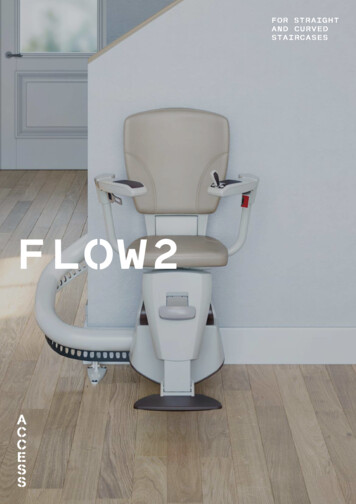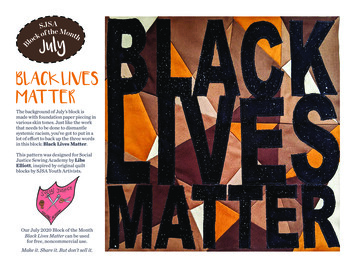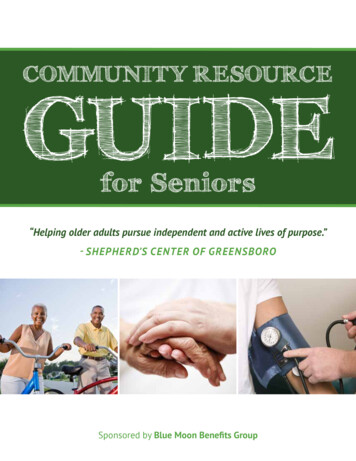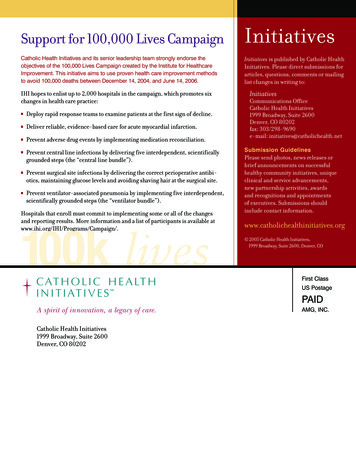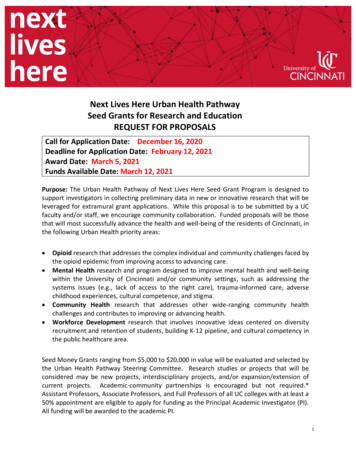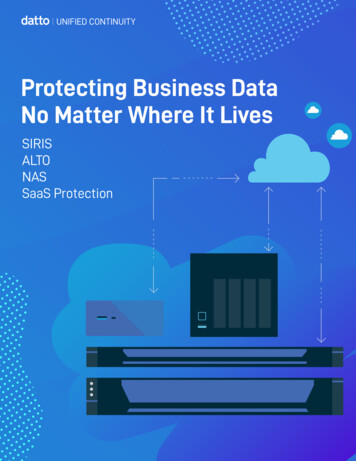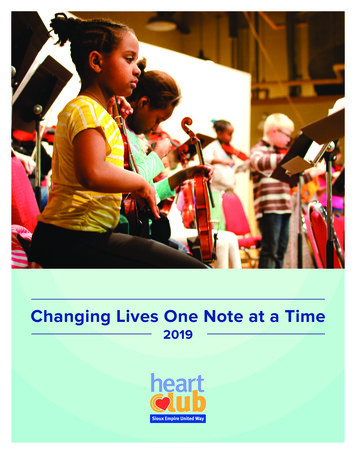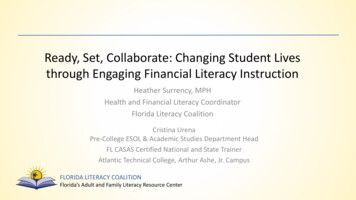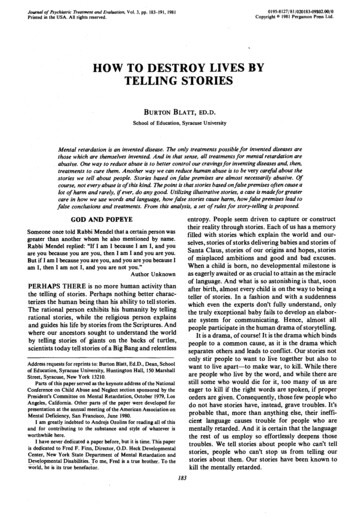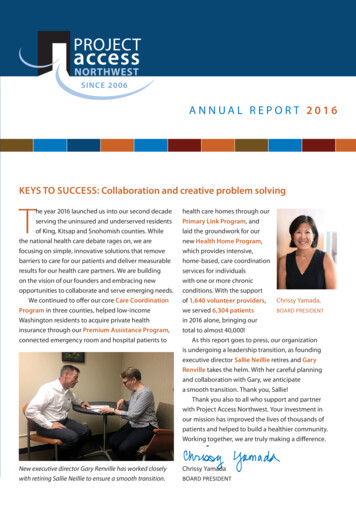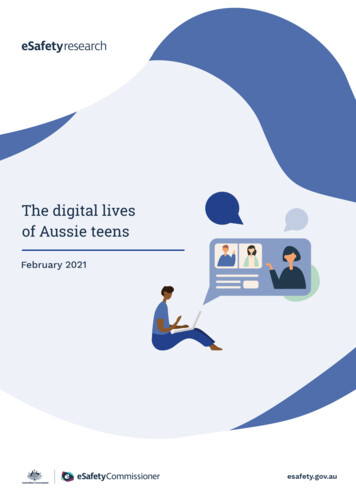
Transcription
The digital livesof Aussie teensFebruary 2021esafety.gov.au
ContentseSafety research program2Overview3Key highlights4Detailed findings7Online lives7Social media9Negative online experiences11Actions taken13Online safety information needs15Trusted sources of information16Positive online behaviours17Conclusion19Methodology20Digital lives of Aussie teensesafety.gov.au
eSafety research programThe eSafety Commissioner (eSafety) supports, encourages, conducts and evaluates research aboutonline safety for Australians. The eSafety research program tracks trends and collects, analysesand interprets data and uses this to provide an evidence base to develop eSafety resources andprograms. eSafety also works closely with domestic and international agencies to proactively identifyand explore current and emerging online safety issues.eSafety research is available at: esafety.gov.au/about-us/researchFor any enquiries about the eSafety research program, please contact research@esafety.gov.au2Digital lives of Aussie teensesafety.gov.au
OverviewIn September 2020, eSafety looked to exploreWhile teens’ increased use of technology offersthe online behaviours and experiences of the firstmany benefits such as being able to researchgeneration of Australian teens to be surroundedtopics of interest and connect with family andby digital devices and the internet since thefriends, there is a downside – teens continue today they were born. Questions for these teensdeal with negative online experiences including– those aged between 12 and 17 years – wereunwanted contact, cyberbullying and harassment.included in an omnibus survey conductedWe can see from this research (when comparedby Omnipoll.to 2017) that teens are proactively taking someform of action after a negative online experienceSince eSafety last looked at the onlinewhether that is managing it themselves, suchexperiences of youth back in 2017, this researchas reporting, or speaking to friends and family.shows the evolution of teens' online behavioursHowever, more work needs to be done to drivein a positive way. In particular, how teens dealbehavioural change given a large percentage ofwith negative online experiences, barriersteens continue to ignore potentially harmfulto help seeking, the types of informationexperiences or believe nothing will change.they need to help them stay safe online andtrusted information sources. It also looks atA surprising finding was that Australian teensthe steps teens have taken to build positiveare active in helping build positive and inclusiverelationships online.online relationships, which could help otherswhen dealing with similar issues online. ThisResults in 2020 show that this group spend awas even more apparent with teens who hadlarge amount of their time online on a range ofpreviously had a negative online experience. Thisactivities. This is not particularly surprising givenis a heartening result and something to be furtherthe critical role the internet played in connectingnurtured to help build a safer and more positivepeople to services, information, friends andonline world. This is particularly important whenfamily during the recent COVID-19 restrictions.the downsides of online engagement are oftenIt highlights that while social media preferencesthe focus of attention in the media.are changing, mainstream players such asYouTube and Facebook continue to capturemuch of this group's attention. Newer services,including TikTok and Discord have, however,made significant inroads into the youth market inAustralia over a relatively short period of time.3Digital lives of Aussie teensesafety.gov.au
Key highlightsThe internet is an integral part of the digital lives of young people in Australia. However, engaging onlinecan be confronting. Although Australian teens are increasingly well informed in dealing with negativeonline experiences, they are keen to find out more about how they can ensure their online safety.Where available, historical comparisons have been made.Online lives Teens spent an average of 14.4 hours a week online – males spent more time online(15 hours) than females (13.8 hours). Teens used the internet for a range of activities, including: researching topics of interest – 95% watching videos, movies or TV – 93% chatting with friends – 93% listening to music – 92% online gaming – 77%.Social media Teens used an average of four different social media services with social media preferencesshifting from mainstream social media to new services. Top social media services used were: YouTube – 72% (compared to 86% in 2017) Instagram – 57% (66% in 2017) Facebook – 52% (66% in 2017) Snapchat – 45% (63% in 2017).TikTok, formerly known as Musical.ly, had substantial growth in active Australian teen users,increasing from 12% in 2017 to 38% in 2020. Discord, established in 2015, was used by 19% ofAustralian teens in 2020. Teens used multiple social media services with the average number increasing with age. Thoseaged 12 to 13 used an average of 3.1 services compared with 4.5 for those aged 16 to 17.4Digital lives of Aussie teensesafety.gov.au
Negative online experiences Just over four in 10 teens had at least one negative online experience in the six months toSeptember 2020 with this increasing to over 50% of those aged 14 to 17. The top five negative online experiences of teens included: being contacted by a stranger or someone not known to them – 30% (26% of males and35% of females) receiving inappropriate, unwanted content such as pornography or violent material – 20% being deliberately excluded from events/social groups – 16% receiving online threats or abuse – 15% (18% of males compared with 11% of females) having things said online to damage their reputation – also 15%.Almost one third (30%) said that their negative online experience related to bullying thatoccurred at school.Actions taken Teens were more likely to deal with a negative experience themselves or talk to familyand friends. The most common actions to address a negative online experience included: blocking the account or person – 54% speaking to family/friends – 43% reporting it – 40% (21% reported to social media companies).Teens who did not report their negative online experience said this was for a range of reasons: they just ignored it – 41% they didn’t think it wasn't serious enough – 34% they didn’t think anything would change – 21%.Online safety information needs Three quarters of teens wanted more online safety information delivered through trustedchannels. The top three online safety information needs of teens were: how to support a friend who is in trouble – 46% how to block someone or use privacy settings on their device – 44% how to report negative online experiences – 40%.5Digital lives of Aussie teensesafety.gov.au
Trusted sources of information Teens' trusted channels for accessing online safety information included: their school or an online safety class – 43% a trusted eSafety website – 40% from a parent/carer – 38%.Positive online behaviours 9 in 10 teens sought to build positive online relationships. Having negative online experiences made teens more aware of the impact of their actions andmotivated them to engage in more positive online behaviours. Nearly 100% of teens who had anegative online experience engaged in positive online behaviour compared with 82% of teenswho had not had a negative online experience. The top three positive behaviours were: posting positive/nice comments about others (86% of those who had a negative onlineexperience compared with 66% of those who had no negative online experience) supporting or listening to a friend who had a bad experience (88% compared with 59%) making sure that peers were not excluded online (83% compared with 60%).6Digital lives of Aussie teensesafety.gov.au
Detailed findingsOnline livesIn September 2020, teens spent an average of 14.4 hours each week online – just over 2 hours a day.Males spent more time online, 15 hours per week on average, compared with females at 13.8 hours aweek. Teens aged 16-17 year olds spent 16.1 hours compared with 14.5 hours for those aged 14-15 and12.5 hours for those aged 12-13. Teens also engaged in a wide range of activities (see Figure 1), andalmost all teens went online to research topics of interest, chat with friends and for entertainmentpurposes such as watching videos, listening to music and playing online games.Figure 1: Teens’ online activities (%)Researching things that interest me9593Watching videos, movies or TV93Listening to music92Playing games online with others77Making video calls72Responding to others' comments72Posting photos/videos online68Accessing news62Doing online banking or online shopping54Q1: Thinking now about what you do online, please indicate which activities you do online? Base: All teens aged 12 to 17 (n 627).The level of engagement in online activities was similar for males and females (Table 1), with two keyexceptions: 87% of males played multiplayer games online (with others) compared with 66% of females 67% of males read news online compared with 56% of females.A larger proportion of 14 to 17 year-olds engaged in online activities than those aged 12 to 13 years (Table 1).The most notable differences were: 75% of 14 to 17 year-olds responded to others' comments compared with 65% of 12 to 13 year-olds 71% of 14 to 17 year-olds posted photos/videos online compared with 60% of 12 to 13 year-olds 69% of 14 to 17 year-olds accessed news compared with 48% of 12 to 13 year-olds 65% of 14 to 17 year-olds conducted online banking/shopping compared with 30% of 12 to 13 year-olds.7Digital lives of Aussie teensesafety.gov.au
Table 1: Teens’ online activities (%)GenderAge (years)TotalMaleFemale12 to 1314 to 17Researching things that interest me9596949395Watching videos, movies or TV9394929094Chatting with friends9394939095Listening to music9291948994Playing games online with others7787668075Responding to others' comments7272726575Making video calls7270746774Posting photos/videos online6866696071Accessing news6267564869Banking or shopping online5451563065Base (number)627313314191436Q1: Thinking now about what you do online, please indicate which activities you do online?8Digital lives of Aussie teensesafety.gov.au
Social mediaTeens used an average of four social media services with the top three being YouTube (almost threequarters), Instagram (around 6 in 10) and Facebook (just over half) (Figure 2).The type of social media services used by teens in Australia has changed since 2017: while YouTube, Instagram, Facebook and Snapchat remain the most popular app/platforms in2020, fewer teens accessed them than in 2017 Tik Tok (formerly Musical.ly) – a service established in 2014 that allows friends to create and shareshort videos – has shown the greatest growth, from 12% of teens in 2017, up to 38% in 2020 Discord – a service established in 2015 that allows friends to communicate directly via voice,video, or text, and during online gaming – was used by less than 1% of teens in 2017, up to 19% in2020 Google was no longer available in 2020 and was previously used by 29% of teens in 2017.Figure 2: Social media services currently used by gender and age (%)72YouTube57Instagram52Facebook39Facebook MessengerTik Tok le 30292223DiscordSkype19164020202017Q2: Which social media platforms or apps do you currently use? Base: All teens aged 12 to 17 (n 627).Older age groups were more likely to use social media services (Table 2), with 12 to 13 year-oldsusing an average of 3.1 services compared with 4.5 for 14 to 17 year-olds – noting that for many,the minimum age for social media accounts is 13. This suggests that some 12 year-olds may not beproviding accurate age information in their profiles.More females used Snapchat (51%) than males (39%), while more males used Discord (27%) thanfemales (11%). Females and older youth were also more likely to use TikTok – 43% females comparedwith 32% of males, and 41% of teens aged 14 to 17 compared with 30% of those aged 12 to 13.9Digital lives of Aussie teensesafety.gov.au
Table 2: Social media services currently used by gender and age (%)GenderAge (years)TotalMaleFemale12 to 1314 to 504257Snapchat4539512654Facebook Messenger3939403442Tik Tok (formerlyMusical.ly, established Discord (established in 2015)1927111223Skype1613181217627313314191436Base (number)Q2: Which social media platforms or apps do you currently use?10Digital lives of Aussie teensesafety.gov.au
Negative online experiencesFour in 10 teens (44%) had a negative online experience in the six months to September 2020 (seeFigure 3). Age played a large part in this.The top three negative experiences for teens online were being contacted by a stranger or someonethey didn't know (30%), being sent unwanted inappropriate content such as pornography or violentcontent (20%) and being deliberately excluded from events/social groups (16%). While detailedcomparisons with 2017 data is not possible due to different survey methodologies, the type ofnegative online experiences reported by young people in 2020 and 2017 remained consistent.Figure 3: Negative online experiences in the six months to September 2020 (%)I was contacted by a stranger or someone I didn’t know3020I was sent inappropriate content, e.g. pornography or violent contentHave had other negative experiences online in the past 6 months16I was deliberately excluded from events/social groups16Things were said online about me to damage to my reputation15I received online threats or abuse15Someone misused my personal information/photos online in a mean way8At least one negative experience44Q3: Have you experienced any of the of the following [negative online experiences] in the past 6 months?Base: All teens aged 12-17 (n 627).The likelihood of having a negative online experience increased with age and gender (Table 3). Justover half of 14 to 17 year-olds had a negative online experience in the six months to September2020 compared with 32% of 12 to 13 year-olds. In comparison, 47% of females had a negative onlineexperience compared with 41% of males. Females were more likely to be contacted by a stranger(35% compared with 26% of males) while males were slightly more likely to receive online threats orabuse (18% compared with 11% of females).11Digital lives of Aussie teensesafety.gov.au
Table 3: Negative online experiences in the six months to September 2020, by gender and age (%)GenderTotalI was contacted by a stranger/someone I didn'tknow30I was sent inappropriate unwanted content*20I have had other negative experiences online in thepast six months16I was deliberately excluded from events/socialgroups16Things were said about me to damage myreputation15I received online threats or abuse15Someone misused my personal information/photosonline in a mean way8Age (years)MaleFemale12 to 1314 to 9659At least one negative online experience4441473251Base (number)627313314191436Q3: Have you experienced any of the of the following [negative online experiences] in the past 6 months? *e.g. pornography orviolent content.12Digital lives of Aussie teensesafety.gov.au
Actions takenMore than 80% of teens took some form of action after a negative online experience and this mostlyrelated to self-help or speaking to family or friends (Figure 4). While there is no comparative totalfor 2017, some comparisons can be made for individual categories, with teens taking a more activeapproach in 2020. The data shows that there may be a shift in the way teens deal with negative onlineexperiences, from informal approaches such as talking to family and friends to more self-help (e.g.blocking, unfriending) and formal reporting. In 2020, 54% of teens blocked the person responsible fortheir negative online experience (compared with 43% in 2017), 43% spoke to family/friends about it(compared with 64% in 2017), and 36% unfriended the offending person (no comparative data from2017). Overall, four in 10 formally reported their experience, 21% to the social media company (13% in2017), and 21% to their school and 10% to someone else.Figure 4: Actions taken by those who had a negative experience (%)54Blocked the person36Unfriend the person who did itSelf help10Retaliated8Closed my account7Did less onlineInformal networks43Spoke to my family/friends about itReported it to social media company21Reported it to my school21Formal networks10Reported it to someone elseOther actions1Q4: What actions, if any, have you taken after this or these negative online experience(s)?Base: Teens who had a negative online experience (n 276).Experiences related to bullying at schoolFor those who had a negative online experience, almost one third (30%) said that it related to bullyingthat occurred at school. This decreased with age – just over one third of those aged 12 to 13 (36%)said their experience(s) related to bullying at school compared with three in 10 for those aged 14 to15, and two in 10 for those aged 16 to 17.Reasons for not reportingThe main reasons for not reporting a negative online experience were that teens chose to ignore it(41%), didn't consider the experience to be serious enough (34%), didn't think that anything wouldchange (21%), felt embarrassed/ashamed or feared retaliation (13% for each) (see Figure 5).13Digital lives of Aussie teensesafety.gov.au
Figure 5: Reasons why teens did not report their negative online experience(s) (%)41I just ignored it34It wasn't serious enough21I didn't think anything would changeI was too embarrassed/ashamed13I thought the person who did it to me would retaliate13I didn't know where to go12I thought I'd get into trouble128Someone else dealt with it for meOther reasons213Can't sayQ5: Why didn't you report this or these negative online experiences?Base: Teens who had reported negative online experience to their school, a social media company, or someone else (n 156).14Digital lives of Aussie teensesafety.gov.au
Online safety information needsThree in four teens identified a range of online safety information that they would like to be ableto access (Figure 6). Teens would most like to find out how to support a friend who is in trouble(46%), closely followed by how to block someone using privacy settings on a device (44%). Four inten teens would like further information about how to report negative online experiences (40%) andwould like to know how to get photos or comments about themselves removed from social mediaplatforms (39%).Figure 6: Types of online safety information teens would like to access (%)46How to support a friend who is in trouble4440How to report online negative experiencesHow to get photos of me or comments about meremoved from social media platforms3933Information about counselling services for teenagers24None/can't sayQ6: What online safety information would you like to have access to? Base: All teens aged 12 to 17 (n 627).Females (43%) and older teens (41%) were more likely than males (35%) and younger teens (35%) towant information on how to remove photos or comments from social media (Table 4).Table 4: Types of online safety information teens would like to have access to, by gender and age (%)GenderAge (years)TotalMaleFemale12 to 1314 to 17How to support a friend who is in trouble4646464347How to block someone using privacy settings on mydevice4443454444How to report online negative experiences4038433742How to have photos of me or comments about meremoved from social media3935433541Information about counselling services for teenagers3330362935Other00010None/can't say2424243021Base (number)627313314191436Q6: What online safety information would you like to have access to?15Digital lives of Aussie teensesafety.gov.au
Trusted sources of informationTeens had definite preferences for how they want to access information about online safety (Table5). The three top ways were through their school or an online safety class (43%), through a trustedwebsite (40%) or from a parent/carer (38%). Those aged 12 to 13 preferred information through schoolor an online safety course (47%) and from a parent/carer (42%) while those aged 14 to 17 wantedinformation through a trusted website (44%) or through school/online safety course (41%).Table 5: How teens want to access online safety information (%)GenderTotalAge (years)MaleFemale12 to 1314 to 1742434741Information provided through my school/ onlinesafety class at school43Through a trusted eSafety website*4041393344From a parent/carer3836404236Through discussion with friends2928303129Via social media3335302138Through online or telephone counselling1917201521Via online newsletter1516141515Other ways12030Can't say1111101310627313314191436Base (number)Q7: How would you like to access online safety information? *Attitudes and awareness of specific sites were not explored inthis survey.16Digital lives of Aussie teensesafety.gov.au
Positive online behavioursWhile faced with online safety challenges, it's heartening that teens in Australia do act to build asafer and inclusive online environment in several ways. Given their wealth of online experience, mostteens (9 in 10) reported that they have done at least one positive thing online. Those who have hadnegative online experiences were more likely to say that they engage in positive behaviours (seeFigure 7). These included: supporting or listening to a friend who had a bad experience (88% of those who had a negativeonline experience compared with 59% who hadn't) posting positive/nice comments about others (86% compared with 66%) making sure that peers are not excluded online (83% compared with 60%).Figure 7: Type of positive online behaviours (%)Supported/listened to a friend who had a bad experience onlinePosted positive or nice comments online about others8360Stood up for my friends/others when they’re being bullied orsomeone was nasty to them online8355Encouraged a friend to report something negative that they hadexperienced online7847Checked facts before posting things online7458Asked for consent before sharing photos or information aboutpeople onlineHad at least one negative online experience8666Made sure I’m not excluding others onlineRemoved or changed a post that had hurt or offended someone885973543068Had no negative online experiencesQ8: Finally, have you done the following [positive online behaviours]?Base: Teens who had a negative online experience (n 276), teens who had no negative online experiences (n 351).While there were minimal differences between genders, older age groups were more likely to say thatthey had done something positive online – 92% of those aged 14 to 17 years compared with 84% ofthose aged 12 to 13. These differences were evident across all types of behaviours (Table 6).17Digital lives of Aussie teensesafety.gov.au
Table 6: Positive online behaviours by gender and age (%)GenderTotalAge (years)MaleFemale12 to 1314 to 6161486747463950Posted positive or nice comments online aboutothers75Supported/listened to a friend who had a badexperience online71Made sure I’m not excluding others online70Stood up for my friends/others when they’re beingbullied or someone was nasty to them online67Checked facts before posting things online65Asked for consent before sharing photos orinformation about people online62Encouraged a friend to report something negativethat they had experienced online61Removed or changed a post that had hurt oroffended someone47At least one positive behaviour8988908492Base (number)627313314191436Q8: Finally, have you done the following [positive online behaviours]?18Digital lives of Aussie teensesafety.gov.au
ConclusionCompared with 2017, teens in Australia appear to be adapting to their online environment, movingfrom informal discussions to more active approaches in dealing with online safety issues. Negativeonline experiences influence and shape the way teens behave online, with those having theseexperiences more likely to engage in positive online behaviours as a result.This report, however, highlights that teens do feel that there are information gaps – not only toaddress their own negative experiences but also to help support others going through similarexperiences. One of the challenges is to make sure that teens are aware of, and have access to,trusted sources of information about online safety, with this group preferring the information to bedelivered through schools or via a trusted website.While this report provides a snapshot of teens’ experiences at the top level, the size of the sample,627, does not allow the findings to be reported by at-risk groups such as LGBTQI or Aboriginal andTorres Strait Islander peoples. eSafety research released in 2020 relating to adults1 has shown thatthese groups experienced online hate speech at more than double the national average. FutureeSafety research projects will investigate the experiences and needs of these diverse communitiesto highlight the voices of those who are potentially most at risk. In 2021, eSafety will undertake amajor youth online safety survey comprising 3,500 young people aged 8 to 17. This survey will providecritical intelligence which will aid in the roll out of programs as a part of eSafety's Protecting voicesat risk online2 statement.1eSafety, Adults’ negative online experiences. August ces-risk-online19Digital lives of Aussie teensesafety.gov.au
MethodologySample and weightingThe target audience for this research was Australian teenagers aged 12 to 17 years old. Data collectionwas undertaken by Omnipoll3 using the non-probability based Lightspeed consumer panel to accesssample members. Non-probability sampling means that not everyone has an equal chance of beingselected to participate in the research. Results may be subject to a range of biases when comparedwith results from research using probability-based sampling4 5. Sample quotas were set for eachstate and territory with interlocking gender by age quotas. Survey responses were weighted based onage, gender and geographical area using data from the Australian Bureau of Statistics’ 2016 Census.All findings presented in this report use weighted data, unless otherwise noted.Data collection and quality assuranceData was collected from 17 to 28 September with 627 in-scope teenagers responding to the surveyvia mobile phone. Data presented in this report have been disaggregated by gender (male and female)and age (12 to 13 years and 14 to 17 years).The total number of completed surveys in the current research, however, does not allow the findingsto be reported separately by LGBTQI , Aboriginal and Torres Strait Islander peoples and other diversecommunities.Notes about analysisData from 2017 is calculated for 12 to 17 year-olds from eSafety's Youth Digital Participation survey.Overall results of this survey were published in State of Play – youth, kids and digital dangersavailable at gers‘Don’t know’ and ‘Refused’ responses are not excluded. Multiple response questions and data maytotal greater than 100%345For further information about the approach taken by Omnipoll, see omnipoll.com.au/omnibusPew Research Center, May 2016, Evaluating Online Nonprobability Surveys. Retrieved 10 November 2020 from pewresearch.org Australian National University Centre for Social Research & Methods and the Social Research Centre, May 2018, The Online PanelsBenchmarking Study: A Total Survey Error comparison of findings from probability-based surveys and nonprobability online panelsurveys in Australia. Retrieved 10 November 2020 from csrm.cass.anu.edu.au20Digital lives of Aussie teensesafety.gov.au
esafety.gov.au
esafety.gov.au 6 Digital lives of Aussie tees Teens' trusted channels for accessing online safety information included: their school or an online safety class – 43% a trusted eSafety website – 40% from a parent/carer – 38%. 9 i
